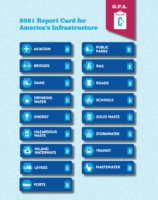US Infrastructure Grade Improves to a C on ASCE Report Card, Bolstered by Federal Funding

Port infrastructure received the highest grade of 18 infrastructure categories graded in the ASCE report, with improvements made possible by recent federal funding increases, including a doubled funding levels for the Port Infrastructure Development Program.
Photo by Charles Csavossy, public domain via Wikimedia Commons
For a high schooler, bringing home a C may not garner praise, but for U.S. infrastructure, its C rating from the American Society of Civil Engineers is the highest grade yet since the group began releasing its report cards in 1998.
“The new grades in 2025 demonstrate that investment in infrastructure makes a difference,” said Darren Olson, chair of the 52-person ASCE committee that puts together the report card and vice president and water resources department head at Christopher B. Burke Engineering Ltd.
He cited the positive impact of the 2021 Infrastructure Investment and Jobs Act and the 2022 Inflation Reduction Act on enabling infrastructure improvement projects. Olson called on Congress and the Trump administration “to continue sustained investment in infrastructure and build on progress made to improve infrastructure after decades of deferred funding and under investment.”
The report—released every four years—measures and grades 18 infrastructure categories individually in addition to the overall grade given, with the range this year spanning Ds at the lowest end given to stormwater, transit and energy, to a B, the highest rating this year, given to ports, whose “funding levels have doubled thanks to federal investments that allow ports to better assess balance and address needs on both land and water,” notes Olson. Rail was close behind at a B-. That a D was the lowest grade is also an improvement; it’s the first time that no category has garnered a D-.
Facing more electrification pressure from electric vehicle use growth, data storage and artificial intelligence, among other catalysts straining power transmission and distribution infrastructure, ASCE downgraded the energy sector to D+ from C-, with at least a $578-billion investment gap predicted by 2033.
“Despite billions in transmission and distribution investment, power generation has stayed the same,” said report contributor Otto Lynch, an electric transmission engineer and CEO of Power Line Systems. ASCE recommendations include a U.S. plan for " rapid restoration of energy systems" after natural and/or human-caused disasters, boosted storage to "mitigate capacity shortfalls" and a "robust national transformer inventory" to ensure quick and cost-effective replacement in emergencies.
Grades for water infrastructure categories, including drinking water (C-) and wastewater (D+) reflect aging infrastructure as well as challenges from extreme weather and “treatment advances necessary for emerging contaminants,” said committee vice chair Carol Haddock, a professor in the practice at Rice University. She notes that “many utilities are improving performance, using innovation to improve the ability to identify issues before they become failures, though only about 30% of our utilities nationwide have fully implemented asset management plans.”
“The ASCE Report shows some momentum in solving [water system] challenges, but there’s more to do,” says Susan Moisio, Jacobs global water program director, highlighting an “integrated, proactive approach that leverages digital technologies, partnerships with the private sector and federal funding opportunities."
For all infrastructure categories to achieve good state of repair status, which ASCE considers a B grade, the estimated needed investment is $9.1 trillion over a ten-year period, according to the organization, leaving a $3.7 trillion gap based off of its spending projections assuming current funding levels—with a larger gap if federal funding levels were reduced.
The report also recommends focusing on resilience to counter damage from increasingly more prevalent extreme weather events and reduce associated costs. In 2024, there were 27 extreme weather events—compared to an overall annual average of 9 from 1980 to now—that each caused more than $1 billion in damage (over $182 billion in total), according to the National Centers for Environmental Information.
Recommended measures by ASCE include adopting the most recent codes, considering climate impacts in capital improvement plans, “encouraging asset management practices to ensure investments are spent wisely” and including life-cycle cost analysis in planning, among others.



